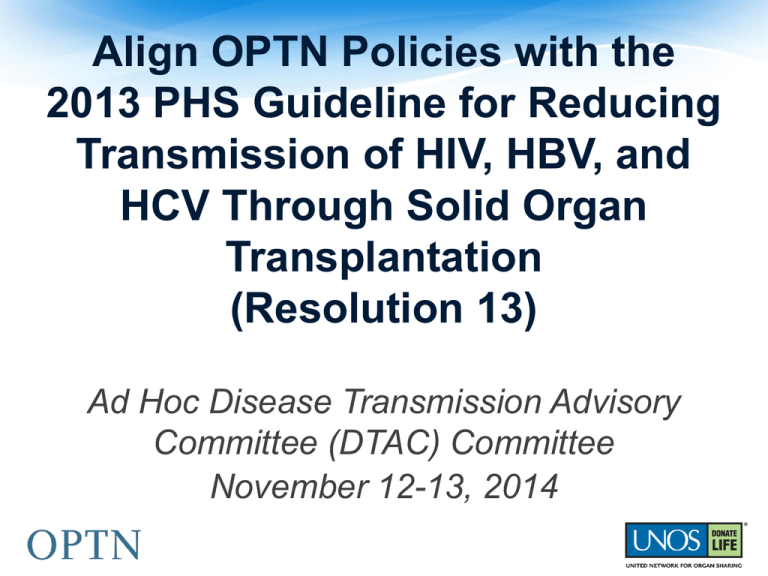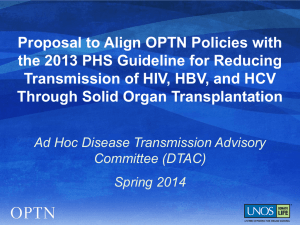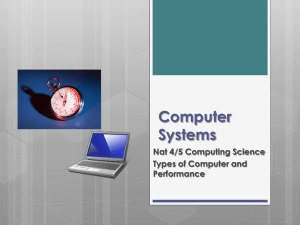DTAC - Transplant Pro
advertisement

Align OPTN Policies with the 2013 PHS Guideline for Reducing Transmission of HIV, HBV, and HCV Through Solid Organ Transplantation (Resolution 13) Ad Hoc Disease Transmission Advisory Committee (DTAC) Committee November 12-13, 2014 The Problem June 2013- US Public Health Service released new PHS Guideline that now include Hepatitis B (HBV) and Hepatitis C (HCV) in addition to HIV The Final Rule, §121.4 (OPTN policies: Secretarial review and appeals.) notes that the OPTN Board is responsible for developing policies consistent with recommendations of the CDC to test potential organ donors and follow transplant recipients to prevent the spread of infectious disease. Current policies are not consistent with new PHS Guideline Strategic Plan #4- Promote Transplant Patient Safety • Improve communication between OPOs and tx hospitals • Increase capacity to identify patient safety issues #5- Promote Living Donor Safety • Develop policy for medical/social evaluation Goal of the Proposal Align OPTN policy with 2013 PHS Guideline to meet Final Rule requirements Enhance transplant recipient and living donor safety through updates to donor and recipient testing, informed consent, and vessel storage How Proposal Achieves its Goals OPOs Tx Hospitals LD Recovery Programs Store samples Develop and implement for serology and written protocol for NAT for 10 yrs post-tx testing for HIV/HBV/HCV (unless + pre-tx) Complete testing for the HIV/HBV/HCV as close to organ recovery as possible but <28 days No donor med/soc = increased risk Clarify informed consent policies - 15.3 HIV NAT or Ag/Ab combo for increased risk donors HIV NAT or Ag/Ab combo for increased risk donors Cannot store HCV Ab or NAT pos or HBsAg or NAT pos extra vessels HCV NAT for ALL donors HCV NAT for ALL donors Programming Includes: HIV, HBV, and HCV NAT data collection fields in DonorNet® for deceased organ donors Fields must display on DonorNet® and DonorNet® mobile Serologies tab where they will reside renamed “Viral Detection” HBV and HCV NAT screening criteria all organ match runs for all organs for deceased and living donors Adds fields to the Waiting List for candidates HIV, HBV, and HCV NAT data collection fields in Tiedi (Transplant Recipient Registration) Additional NAT fields on LDR/DDR already being implemented as part of OMB project Joint Subcommittee Composition OPTN Committees DTAC Living Donor OPO Operations & Safety Professional Societies AOPO AST ASTS NATCO Government Ex Officio HRSA FDA SRTR invited, but did not participate. Representatives received all emails and open invite to attend as desired. Proposal Development Joint Subcommittee completing comprehensive review of Guideline’s 34 recommendations to determine: Is the PHS recommendation covered by the Final Rule? Is there policy already in place to address this? Does it need to be changed? Should there be policy in place to address this, or should it remain a PHS recommendations? Proposal Development Strong agreement on addressing the 34 PHS recommendations and subsections within joint subcommittee and DTAC with one exception Split vote on this topic from both groups… HCV nucleic acid testing (NAT) for ALL organ donors Committee unanimously supported HIV and HCV NAT for increased risk donors, but could not come to agreement on universal HCV NAT Why is this an issue? The Final Rule, §121.4, notes that the OPTN Board of Directors is responsible for developing policies that are consistent with recommendations of the Centers for Disease Control and Prevention (CDC) to test potential organ donors and following transplant recipients to prevent the spread of infectious disease. Public Comment Feedback Public Comment Response Tally Type of Response Response Total Individual 29 Regional 11 Committee 19 In Favor 22 (76%) 10 (91%) 6 (32%) No Vote/ In Favor as No Amended Opposed Comment/ Did Not Consider 0 5 (17%) 2 1 (9%) 0 0 0 1 (5%) 12 Professional Society Feedback ASTS AST NATCO • Oppose due to universal HCV NAT requirement • Oppose due to universal HCV NAT requirement • Supports policy as written Comment Themes Several themes arose in reviewing feedback, and are outlined in detail on page 45 of the briefing paper, Exhibit A ,in the DTAC’s board report. NAT Concerns Issues Raised DTAC Comments Desire for standardization • Challenging, but outside of NAT across platforms of OPTN purview. Guidance on how to proceed with initial positive (e.g. Triplex) • Thresholds for pos test results are set by industry and FDA. How to proceed with possible false positive tests • OPOs and tx centers should work closely with their labs and carefully review FDA guidance, testing package inserts NAT Concerns Issues Raised DTAC Comments Concerns related to access to NAT in some donor service areas. • Most OPOs have capacity to perform NAT • A variety of process issues could result in delayed or lost donors Could a NAT requirement lead to delayed donation or lost donors? OPO NAT Survey Results OPOs performing NAT for screening of potential deceased organ donors Year 2008 HIV NAT 44/58 (76%) HBV NAT 20/58 (34%) HCV NAT 40/58 (69%) 2010 56/57 (98%) 43/57 (75%) 55/57 (97%) OPOs performing NAT for screening of all potential deceased organ donor, regardless of risk status Year 2008 2010 HIV NAT 30/58 (52%) 39/57 (68%) HBV NAT 14/58 (24%) 30/57 (53%) HCV NAT 28/58 (48%) 39/57 (68%) NAT Concerns Issues Raised DTAC Comments OPO Committee supported Increased false universal HCV NAT, suggesting: positives in low • danger in assuming that a prevalence population sub-group of potential donors with organ wastage be assumed as “no increased risk” and allow for exemption (e.g. pediatric donors) from testing requirements. Final Rule does not allow for the exclusion of any specific group False positive NAT results Proportion of false positives depends on incidence in population Further testing to clarify initial results rarely practical in deceased donors Labs and test package inserts report an extremely low incidence of false positive rates. 9179 NAT (HIV/HCV) runs in organ or tissue donors 0.9% initially reactive but not repeatable 0.04% reactive but not discriminated 0.001% inhibitors and could not be amplified 3 (0.03%) NAT reactive and seronegative for HIV-1, HCV Personal communication, Marek Nowicki, Nat Institute of Transplantation HCV donor-derived infection Jan 2008 to October 2013 DTAC Experience with Donor Hepatitis C Testing; WTC 2014 Additional Comment Themes Timeline for implementation: OPOs and transplant hospitals need time to develop new internal procedures and testing protocols. Hemodialysis as an increased risk factor for HCV only Education materials for patients considering increased risk organs How to handle recipient consent if potential living donor meets increased risk criteria Overall Project Impact Product Policy Programming Related education Target Population Impact: Deceased and Living Donors Transplant Candidates and Recipients Total IT 4,500/10,680 Implementation Hours Total Overall 4,950/17,885 Implementation Hours 4500 0 1000 2000 3000 4000 5000 4950 0 2000 4000 6000 Post-Public Comment Modifications Added clarification that HIV NAT is not required when dialysis is only risk factor For living and deceased donors Modifications to nomenclature for viruses to be consistent between living and deceased donor language Addition to include appropriate living donor reference since it applies to living and deceased donors Proposed Amendment to Language (lines 90 and 97, page 24 of book) 2.9 Required Deceased Donor Infectious Disease Testing e. Hepatitis C ribonucleic acid (RNA) by donor screening or diagnostic nucleic acid test (NAT) If a deceased donor is identified as being at increased risk for HIV, HBV, and HCV transmission according to the U.S. Public Health Services (PHS) Guideline, testing must also include HIV ribonucleic acid (RNA) by donor screening or diagnostic NAT or HIV antigen/antibody (Ag/Ab) combination test. This does not apply to donors whose only increased risk factor is receiving hemodialysis within the preceding 12 months, as they are at risk only for HCV according to the U.S. Public Health Services (PHS) Guideline. Resolution 13 (page 22) RESOLVED, that additions and modifications to Policies 2.2 (OPO Responsibilities), 2.4 (Deceased Donor Medical and Behavioral History), 2.7.B (Informing Personnel), Table 14-2 (Requirements for Living Kidney Donor Medical Evaluations) with the exception of NATrelated requirements, 15.3 (Informed Consent of Transmissible Disease Risk), 15.3.A (Deceased Donors with Additional Risk Identified Pre-transplant), 15.3.B (Deceased Donor at Increased Risk for Transmission of Blood-borne Pathogens), and 16.7.B (Vessel Storage) as set forth in Exhibit A, are hereby approved, effective February 1, 2015. and… Resolution 13 (page 22) FURTHER RESOLVED, that additions and modifications related to donor nucleic acid testing (NAT) requirements in Policy 2.9 (Required Deceased Donor Infectious Disease Testing) and Table 14-2 (Requirements for Living Kidney Donor Medical Evaluations) as set forth in Exhibit A, are hereby approved, effective pending programming and notice to the OPTN membership. Questions? Thank you! Daniel Kaul, MD, Committee Chair kauld@med.umich.edu Shandie Covington, Committee Liaison shandie.covington@unos.org








